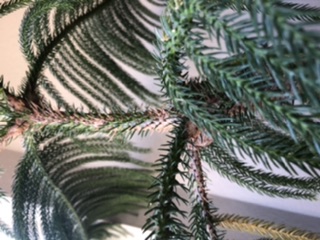
Hi thank you for your assistance. I am in an errand climate in Colorado near Denver and I have had in Norfolk Pine for 10 years. It has been happily growing in a bay window with lots of indirect light.it has a little bit of new growth at the top however there appears to be a sap emerging from the tip in the form of a cluster of small bubbles. Furthermore at the base of the branches at the trunk, there are woody bulbous-like formations. How can I help this plant? Thank you.
Thank you for contacting the Toronto Master Gardeners. Unfortunately, it is difficult for me to see from your photo the cluster of small bubbles or the wooden bulbous-like formations.
In general, Norfolk Island pines need several hours of sunlight per day, but they do not like direct sunlight. A good location for this plant is in a room with lots of northeast- or northwest-facing windows.
Your watering frequency will depend on the humidity in your house and the time of year. During the winter your tree is not really growing so allow the soil to dry out before waterings. From spring to fall, water more frequently to promote healthy, even growth. As with any plant, fertilize your pine when it is actively growing (between spring and fall). Every two weeks, provide your pine with a mild fertilizer (10-10-10) made for indoor plants, making sure to follow dilution directions on the package.
Norfolk Pines are tropical plants and as a result, prefer high humidity. Make sure to mist your plants once a week or more frequently if you notice that needles are turning brown. These pines prefer cooler temperatures and consistency: avoid drafts and vents and allow it to enjoy about 18°C.
Norfolk Pines aren’t fond of re-potting and can be kept in the same pot for many years. Check the root system of your pine every few years. If the root ball is bound and there is little soil left, consider re-potting. Always re-pot in the spring and use a fast-draining potting soil mix for best results.
The most common environmental problem seen in these plants is needle browning resulting from overwatering, underwatering, or too much sun.
Norfolk Island Pines are vulnerable to pests including aphids, mealybug and scale.
Check your plant for aphids. The bubbly substance you are observing on the growing tip of your plant could be the honeydew produced by aphids. Adult aphids are pear-shaped, measuring less than 1/8 inch in length. Aphids cause damage by sucking sap from new growth on plants. They tend to cluster at the growing tips of plants and attach themselves to the soft, green stems. As a result, the new foliage may look crinkled or stunted. the honeydew secreted by aphids can encourage the growth of sooty mold and fungus.
Like most pests, the best control for aphids is defensive. Healthy, vigorous plants are less susceptible to infestation than weak, underpotted, and stressed plants.
In most cases aphids can be washed off your plant with a strong blast of water. Your plant needs to be sprayed with water every 10 days to break the life cycle of the aphids.
For a severe infestation you may consider spraying your plant with insecticidal soap which is available at your local garden center. Make sure to follow the instructions on the bottle.
Mealybug infestations appear on plants as tiny, soft-bodied insects surrounded by a fuzzy, white mass around the stems and leaf nodes. As you don’t mention seeing a white fuzzy mass I assume you do not have mealybugs.
Scale, or armoured and soft scale bugs are tiny insects that attach themselves to the stems or leaves of a plant and remain in the same spot throughout their lives, feeding on the plant juices. Young scales or crawlers that have not attached themselves yet look like tiny yellow or orange spots. Armored scales do not secrete honeydew but soft scales do. They are commonly light tan but this varies depending on the species and life stage. Severe infestations can cause plant leaves to wilt, yellow and fall from the plant. If there is honeydew present it should be washed off.
Scale insects are difficult to control because the waxy or cottony covering serves as a protective barrier to traditional contact insecticides. To rid your plants of scale, you may wish to remove them physically with your fingernail or some tweezers
The following website provides quite a lot of good information on scale and its management.
https://hortnews.extension.iastate.edu/scale-insects
Lastly, you may wish to contact the Colorado Master Gardeners . They may have other insight as what the bulbous growth could be.

